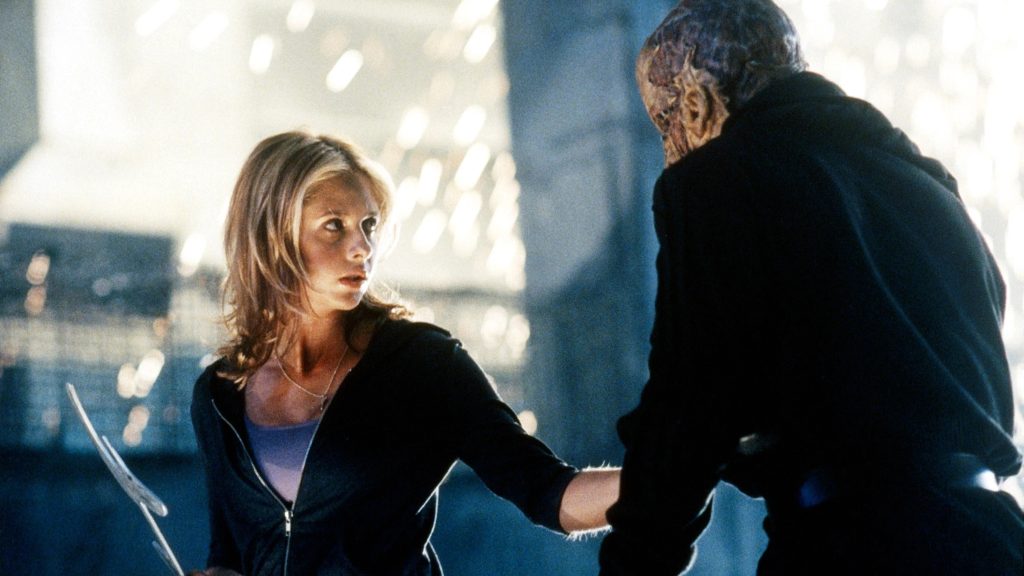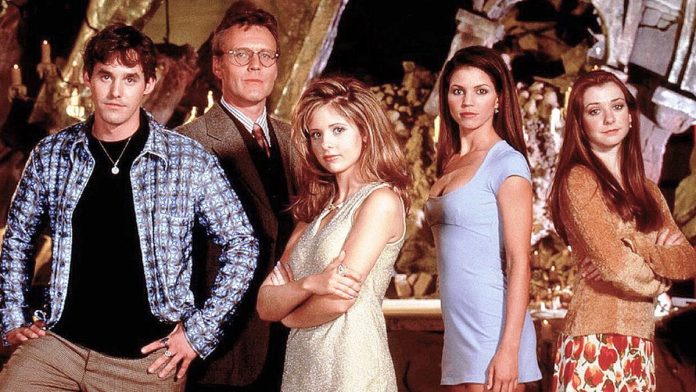A new Buffy the Vampire Slayer spin-off audio series has been released by Audible titled Slayers: A Buffyverse Story and features a number of the original cast who return to voice their roles. But as fans of the original show brace themselves for the revival of their favourite characters, how will Buffy fare in the ears of today’s audiences?
An empowered, strong woman was still a relatively new concept in the 1990s; before that, there was a distant wasteland of male hero stereotypes and glamorised, romanticised women who shouldn’t fight for fear of chipping a nail. The definitive action flicks of the two decades prior were littered with archetypal ‘men of the hour’, with Rambo, Top Gun, Indiana Jones, Die Hard, and Lethal Weapon all setting the tone for at least the next 10 years of cinema—or so we thought. And it seems television wasn’t in great shape either as it aired Knight Rider, another incarnation of G.I. Joe, MacGyver, and the list goes on.
Ripley changed that in 1979. Ridley Scott’s Alien has long been commended for its inclusion of a female protagonist and the way in which it was handled, especially for its time. Naturally, some critics feel there are some problems with the character played by Sigourney Weaver, such as the fact she is portrayed as overtly masculine. Although, rather famously, the character was originally written as a male.
By the time Buffy came along there had been attempts made to replicate the female action-hero, but many missed the mark. However, Sarah Michelle Gellar’s Buffy embodied the relevant, relatable persona of a woman of her time and, all the while, continued to slay (vampires). Just take a line from one of the first episodes: “Clark Kent has a job—I just want to go on a date. I won’t go far, okay! If the apocalypse comes, beep me!” To travel from an era bereft of female heroes to one where audiences were seeing more emerge that were getting it right, Buffy was, and still remains, a marvel for its time.
Story
The show, which aired from 1997 to 2003, followed its titular character as she navigated the most painful work-life balance known to man—school work (and then eventually college followed by real employment) and slaying vampires. Her friends, Willow (Alyson Hannigan) and Xander (Nicholas Brendon), helped—but also often hindered—her along the way, while her Watcher or mentor Rupert Giles (Anthony Head) guided Buffy in her quest to rid the world of monsters.
Much like any television series, it had its height of critical acclaim as well as its low points, but generally it had a good habit of returning to what fans really loved about it—its character-driven storytelling. Of course, it had its rogue episodes where the central characters would interact with others who wouldn’t normally appear or where drama would be created by a threat, but the best of the show came in the drama created by the main characters. For an audio series, it isn’t hard to imagine the amount of character-driven storytelling it could contain.
Characterisation
Buffy is a teenage girl trying to find her place in school, never mind the world. She’s worrisome over her rather depressing, confined future and asks the big questions. She lives with the knowledge that until she dies, she will be the only slayer there to save the world—a daunting task which she doesn’t take lightly. Unlike her friends, who have their pick of colleges and jobs, her future has already been decided, whether she likes it or not.

It was aimed at teenagers, however, unlike other shows of its time, Buffy didn’t mock their intelligence or taste—it made these strengths. The show incorporates dark themes into an often “campy” or wacky atmosphere. Seeing monsters running away from a teenage girl rather than the other way around was massively appealing to audiences, and remains so now.
Though the show was aimed at teens, it never shies away from challenging its audience, which is part of the reason it was so ahead of its time. Buffy was very different to other television during the years it aired, often paving the way for others to follow. For example, Battlestar Galactica had a habit of taking itself too seriously—something Buffy was better at riding the line with. The show’s audience were (and still are) mainly teenage girls, which can see companies tailoring specific messaging towards them—often to their detriment. The habit of stereotyping a particular audience by propelling the same stories and themes has long been exhausted. Though, this was not the case with Buffy because it understood its audience.
A good example of this is Willow’s sexuality and her journey to self acceptance. Though fraught with tragedy, Willow’s story is handled delicately as she discovers who she is and what she wants, especially in the early stages of the show. Willow and Tara’s (Amber Benson) relationship was the first long-term lesbian relationship on US television and it received applause for its queer representation by putting the pair’s storyline at the forefront of storytelling. In some ways, it transformed the way people saw representation on screen. At first it was a huge part of the story but soon became normalised and served as exposure, which ultimately led to many fans being able to relate to Willow.
Buffy contains commentary on social standing, be this in school or in employment. For example, Buffy finds herself having to drop out of college to pursue a job when she is thrust into the role of the breadwinner in her family. The responsibility is huge and unexpected, but it’s also all too real and relatable to many. This works well for the show in that the themes transcend time, meaning what was topical then still echoes true now.
Bringing Buffy Into the Now

There is no doubt Buffy could easily find a comfortable audience in the fans it already has, but gaining a new following may be a more difficult task. The audio series has the potential to thrive in today’s environment, so long as it leaves some of its qualms in the past.
When Buffy first released, vampires were very established in the film and TV world. However, as time has moved on, vampires as a theme is now an oversaturated market. Twilight did a lot for the genre in itself, as well as True Blood, The Vampire Diaries, and What We Do in the Shadows (which had an original film and a follow-up BBC series). The selection is bountiful and spans on and on; it no longer feels new and exciting unless the concept is given a new direction. Perhaps if the writers of this new series can find a way of tweaking how we think of the vampires in the Buffyverse, there is a chance the stories could feel more fresh. But if Buffy continues to do what it always did best—character drama—we should be in safe hands.
A major decision was taken in the Audible series to make Spike (James Marsters) the focus of the stories. A fan-favourite, the vampire was introduced to the show in the second season as the villain. However, his likability did the actor a world of favours as he was signed on to more episodes after an influx of popularity. Suddenly, Spike was a staple in the show and he wasn’t going anywhere, even developing into a conflicted hero and eventual love interest. It’s arguably one of the greatest arcs in television, and seeing the audio series decide to follow this story seems the safest bet and possibly the most lucrative.
Diversity is a major concern for many shows that premiered before the 2010s. In Hollywood the majority of black actors were placed in the roles of secondary characters, especially within the genre of supernatural and horror. Friends features six main characters, all of which are white, and the same goes for Buffy the Vampire Slayer. The most representation comes from Kendra (Bianca Lawson), who was a short lived fellow Slayer. Women of colour were in short supply right until the end, but the audio series has time to correct this. With the narrative focusing on Spike, there is a real opportunity to introduce new, interesting characters who can address this problem; to not do this would be criminal in today’s climate.
Though some could argue that Buffy the Vampire Slayer is a dated concept, you could also say its era-defining qualities are due for a revival as original ideas continue to dry up.
Slayers: A Buffyverse Story is available to listen to on Audible.
Support The Indiependent
We’re trying to raise £200 a month to help cover our operational costs. This includes our ‘Writer of the Month’ awards, where we recognise the amazing work produced by our contributor team. If you’ve enjoyed reading our site, we’d really appreciate it if you could donate to The Indiependent. Whether you can give £1 or £10, you’d be making a huge difference to our small team.
